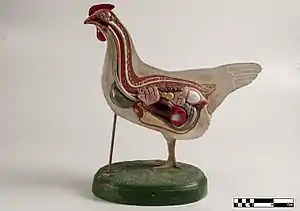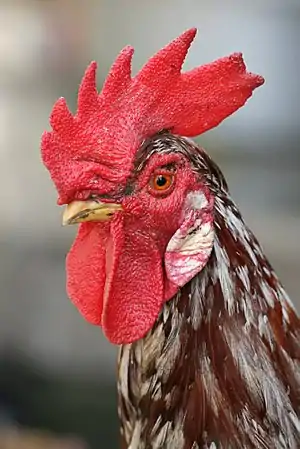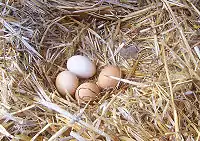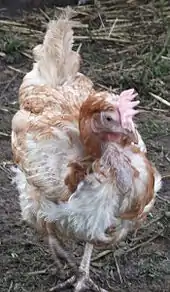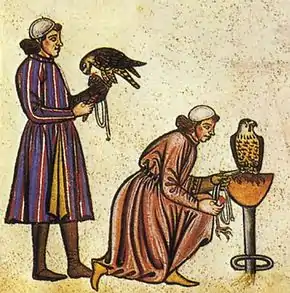Chicken
The chicken (Gallus gallus domesticus), a subspecies of the red junglefowl, is a type of domesticated fowl. Chickens are one of the most common and widespread domestic animals, with a total population of 23.7 billion as of 2018,[1] up from more than 19 billion in 2011.[2] There are more chickens in the world than any other bird.[2] Humans keep chickens primarily as a source of food (consuming both their meat and eggs) and, less commonly, as pets. Originally raised for cockfighting or for special ceremonies, chickens were not kept for food until the Hellenistic period (4th–2nd centuries BCE).[3][4]
| Chicken | |
|---|---|
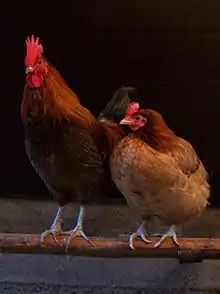 | |
| A rooster (left) and hen perching on a roost | |
Domesticated | |
| Scientific classification | |
| Kingdom: | Animalia |
| Phylum: | Chordata |
| Class: | Aves |
| Order: | Galliformes |
| Family: | Phasianidae |
| Genus: | Gallus |
| Species: | |
| Subspecies: | G. g. domesticus |
| Trinomial name | |
| Gallus gallus domesticus | |
Genetic studies have pointed to multiple maternal origins in South Asia, Southeast Asia, and East Asia,[5] but the clade found in the Americas, Europe, the Middle East and Africa originated from the Indian subcontinent. From ancient India, the chicken spread to Lydia in western Asia Minor, and to Greece by the 5th century BCE.[6] Fowl have been known in Egypt since the mid-15th century BCE, with the "bird that gives birth every day" having come from the land between Syria and Shinar, Babylonia, according to the annals of Thutmose III.[7][8][9]
There are numerous cultural references to chickens – in myth, folklore and religion, and in language and literature.
Terminology
- capons, castrated or neutered roosters[lower-alpha 1]
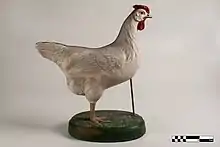 Didactic model of a chicken.
Didactic model of a chicken. - chickens, originally referred to young domestic fowl[10] (see chick)
- chicks, young chickens
- chooks /tʃʊk/ (Australia, New Zealand, sometimes Britain), generic term which describes all ages and both sexes[11]
- cocks (UK and Ireland), adult male chickens over the age of one year
- cockerels, males less than a year old[12]
- hens, females over a year old
- pullets, females younger than a year old,[13] although in the egg-laying industry, a pullet becomes a hen when she begins to lay eggs, at 16 to 20 weeks of age
- roosters (United States, Canada, Australia and New Zealand), see cock
- yardbirds, (slang term in the Deep South of the United States), all chickens (see chook)[14]
Chicken once referred to young domestic fowl in general. The species as a whole was then called domestic fowl, or just fowl. This use of chicken survives in the phrase Hen and Chickens, sometimes used as a British public house or theatre name, and to name groups of one large and many small rocks or islands in the sea . The "hen and chickens" was also a name for the pentacycle, an early design of cargo cycle which had a large central driving wheel surrounded by four small stabiliser wheels.
General biology and habitat
Chickens are omnivores.[15] In the wild, they often scratch at the soil to search for seeds, insects and even animals as large as lizards, small snakes,[16] or young mice.[17]
The average chicken may live for five to ten years, depending on the breed.[18] The world's oldest known chicken was a hen which died of heart failure at the age of 16 years according to the Guinness World Records.[19]
Roosters can usually be differentiated from hens by their striking plumage of long flowing tails and shiny, pointed feathers on their necks (hackles) and backs (saddle), which are typically of brighter, bolder colours than those of females of the same breed. However, in some breeds, such as the Sebright chicken, the rooster has only slightly pointed neck feathers, the same colour as the hen's. The identification can be made by looking at the comb, or eventually from the development of spurs on the male's legs (in a few breeds and in certain hybrids, the male and female chicks may be differentiated by colour). Adult chickens have a fleshy crest on their heads called a comb, or cockscomb, and hanging flaps of skin either side under their beaks called wattles. Collectively, these and other fleshy protuberances on the head and throat are called caruncles. Both the adult male and female have wattles and combs, but in most breeds these are more prominent in males. A muff or beard is a mutation found in several chicken breeds which causes extra feathering under the chicken's face, giving the appearance of a beard. Domestic chickens are not capable of long distance flight, although lighter chickens are generally capable of flying for short distances, such as over fences or into trees (where they would naturally roost). Chickens may occasionally fly briefly to explore their surroundings, but generally do so only to flee perceived danger.
Social behaviour

.jpg.webp)
Chickens are gregarious birds and live together in flocks. They have a communal approach to the incubation of eggs and raising of young. Individual chickens in a flock will dominate others, establishing a "pecking order", with dominant individuals having priority for food access and nesting locations. Removing hens or roosters from a flock causes a temporary disruption to this social order until a new pecking order is established. Adding hens, especially younger birds, to an existing flock can lead to fighting and injury.[20] When a rooster finds food, he may call other chickens to eat first. He does this by clucking in a high pitch as well as picking up and dropping the food. This behaviour may also be observed in mother hens to call their chicks and encourage them to eat.
A rooster's crowing is a loud and sometimes shrill call and sends a territorial signal to other roosters.[21] However, roosters may also crow in response to sudden disturbances within their surroundings. Hens cluck loudly after laying an egg, and also to call their chicks. Chickens also give different warning calls when they sense a predator approaching from the air or on the ground.[22]
Courtship
To initiate courting, some roosters may dance in a circle around or near a hen ("a circle dance"), often lowering the wing which is closest to the hen.[23] The dance triggers a response in the hen[23] and when she responds to his "call", the rooster may mount the hen and proceed with the mating.
More specifically, mating typically involves the following sequence: 1. Male approaching the hen. 2. Male pre-copulatory waltzing. 3. Male waltzing. 4. Female crouching (receptive posture) or stepping aside or running away (if unwilling to copulate). 5. Male mounting. 6. Male treading with both feet on hen's back. 7. Male tail bending (following successful copulation).[24]
Nesting and laying behaviour
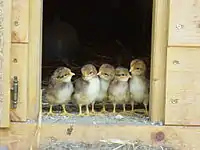
Hens will often try to lay in nests that already contain eggs and have been known to move eggs from neighbouring nests into their own. The result of this behaviour is that a flock will use only a few preferred locations, rather than having a different nest for every bird. Hens will often express a preference to lay in the same location. It is not unknown for two (or more) hens to try to share the same nest at the same time. If the nest is small, or one of the hens is particularly determined, this may result in chickens trying to lay on top of each other. There is evidence that individual hens prefer to be either solitary or gregarious nesters.[25]
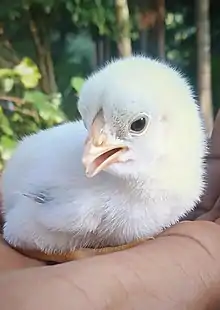
Broodiness
Under natural conditions, most birds lay only until a clutch is complete, and they will then incubate all the eggs. Hens are then said to "go broody". The broody hen will stop laying and instead will focus on the incubation of the eggs (a full clutch is usually about 12 eggs). She will "sit" or "set" on the nest, protesting or pecking in defense if disturbed or removed, and she will rarely leave the nest to eat, drink, or dust-bathe. While brooding, the hen maintains the nest at a constant temperature and humidity, as well as turning the eggs regularly during the first part of the incubation. To stimulate broodiness, owners may place several artificial eggs in the nest. To discourage it, they may place the hen in an elevated cage with an open wire floor.
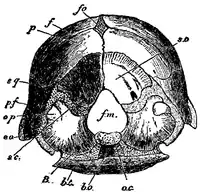
Breeds artificially developed for egg production rarely go broody, and those that do often stop part-way through the incubation. However, other breeds, such as the Cochin, Cornish and Silkie, do regularly go broody, and they make excellent mothers, not only for chicken eggs but also for those of other species — even those with much smaller or larger eggs and different incubation periods, such as quail, pheasants, ducks, turkeys, or geese.
Hatching and early life
Fertile chicken eggs hatch at the end of the incubation period, about 21 days.[23] Development of the chick starts only when incubation begins, so all chicks hatch within a day or two of each other, despite perhaps being laid over a period of two weeks or so. Before hatching, the hen can hear the chicks peeping inside the eggs, and will gently cluck to stimulate them to break out of their shells. The chick begins by "pipping"; pecking a breathing hole with its egg tooth towards the blunt end of the egg, usually on the upper side. The chick then rests for some hours, absorbing the remaining egg yolk and withdrawing the blood supply from the membrane beneath the shell (used earlier for breathing through the shell). The chick then enlarges the hole, gradually turning round as it goes, and eventually severing the blunt end of the shell completely to make a lid. The chick crawls out of the remaining shell, and the wet down dries out in the warmth of the nest.
Hens usually remain on the nest for about two days after the first chick hatches, and during this time the newly hatched chicks feed by absorbing the internal yolk sac. Some breeds sometimes start eating cracked eggs, which can become habitual.[26] Hens fiercely guard their chicks, and brood them when necessary to keep them warm, at first often returning to the nest at night. She leads them to food and water and will call them toward edible items, but seldom feeds them directly. She continues to care for them until they are several weeks old.
Defensive behaviour
Chickens may occasionally gang up on a weak or inexperienced predator. At least one credible report exists of a young fox killed by hens.[27][28][29] A group of hens have been recorded in attacking a hawk that had entered their coop.[30]
Embryology
Chicken embryos have long been used as model systems to study developing embryos. Large numbers of embryos can be provided by commercial chicken farmers who sell fertilized eggs which can be easily opened and used to observe the developing embryo. Equally important, embryologists can carry out experiments on such embryos, close the egg again and study the effect later on. For instance, many important discoveries in the area of limb development have been made using chicken embryos, such as the discovery of the apical ectodermal ridge (AER) and the zone of polarizing activity (ZPA) by John W. Saunders.[31]
In 2006, scientists researching the ancestry of birds "turned on" a chicken recessive gene, talpid2, and found that the embryo jaws initiated formation of teeth, like those found in ancient bird fossils. John Fallon, the overseer of the project, stated that chickens have "...retained the ability to make teeth, under certain conditions... ."[32]
Genetics and genomics
Given its eminent role in farming, meat production, but also research, the house chicken was the first bird genome to be sequenced.[33] At 1.21 Gb, the chicken genome is considerably smaller than other vertebrate genomes, such as the human genome (3 Gb). The final gene set contained 26,640 genes (including noncoding genes and pseudogenes), with a total of 19,119 protein-coding genes in annotation release 103 (2017), a similar number of protein-coding genes as in the human genome.[34]
Physiology
Populations of chickens from high altitude regions like Tibet have special physiological adaptations that result in a higher hatching rate in low oxygen environments. When eggs are placed in a hypoxic environment, chicken embryos from these populations express much more hemoglobin than embryos from other chicken populations. This hemoglobin also has a greater affinity for oxygen, allowing hemoglobin to bind to oxygen more readily.[35][36]
Breeding
Origins
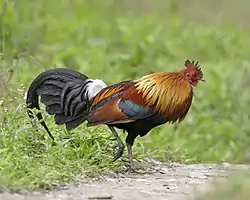
Galliformes, the order of bird that chickens belong to, is directly linked to the survival of birds when all other dinosaurs went extinct. Water or ground-dwelling fowl, similar to modern partridges, survived the Cretaceous–Paleogene extinction event that killed all tree-dwelling birds and dinosaurs.[37] Some of these evolved into the modern galliformes, of which domesticated chickens are a main model. They are descended primarily from the red junglefowl (Gallus gallus) and are scientifically classified as the same species.[38] As such, domesticated chickens can and do freely interbreed with populations of red junglefowl.[38] Subsequent hybridization of the domestic chicken with grey junglefowl, Sri Lankan junglefowl and green junglefowl occurred[39] with at least, a gene for yellow skin was incorporated into domestic birds through hybridization with the grey junglefowl (G. sonneratii).[40] In a study published in 2020, it was found that chickens shared between 71% - 79% of their genome with red junglefowl, with the period of domestication dated to 8,000 years ago.[39]
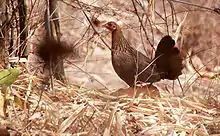
The traditional view is that chickens were first domesticated for cockfighting in Asia, Africa, and Europe.[3] In the last decade, there have been a number of genetic studies to clarify the origins. According to one early study, a single domestication event which took place in what now is the country of Thailand gave rise to the modern chicken with minor transitions separating the modern breeds.[41] However, that study was later found to be based on incomplete data, and recent studies point to multiple maternal origins, with the clade found in the Americas, Europe, Middle East, and Africa, originating from the Indian subcontinent, where a large number of unique haplotypes occur.[42][43] The red junglefowl, known as the bamboo fowl in many Southeast Asian languages, is well adapted to take advantage of the vast quantities of seed produced during the end of the multi-decade bamboo seeding cycle, to boost its own reproduction.[44] In domesticating the chicken, humans took advantage of this predisposition for prolific reproduction of the red junglefowl when exposed to large amounts of food.[45]
Several controversies still surround the time the chicken was domesticated. Recent molecular evidence obtained from a whole-genome study published in 2020 reveals that the chicken was domesticated 8,000 years ago.[39] Though, it was previously thought to have been domesticated in Southern China in 6000 BC based on paleoclimatic assumptions[46] which has now raised doubts from another study that question whether those birds were the ancestors of chickens today.[47] The majority of the world's domestic chickens may be traced to the Harappan culture of the Indus Valley. Eventually, the chicken moved to the Tarim basin of central Asia. It reached Europe (Romania, Turkey, Greece, Ukraine) about 3000 BC.[48] Introduction into Western Europe came far later, about the 1st millennium BC. Phoenicians spread chickens along the Mediterranean coasts as far as Iberia. Breeding increased under the Roman Empire, and was reduced in the Middle Ages.[48] Genetic sequencing of chicken bones from archaeological sites in Europe revealed that in the High Middle Ages chickens became less aggressive and began to lay eggs earlier in the breeding season.[49]
Middle Eastern chicken remains go back to a little earlier than 2000 BC, in Syria; chickens went southward only in the 1st millennium BC. They reached Egypt for purposes of cockfighting about 1400 BC, and became widely bred only in Ptolemaic Egypt (about 300 BC).[48] Little is known about the chicken's introduction into Africa. It was during the Hellenistic period (4th-2nd centuries BC), in the Southern Levant, that chickens began widely to be widely domesticated for food.[4] This change occurred at least 100 years before domestication of chickens spread to Europe.
Three possible routes of introduction into Africa around the early first millennium AD could have been through the Egyptian Nile Valley, the East Africa Roman-Greek or Indian trade, or from Carthage and the Berbers, across the Sahara. The earliest known remains are from Mali, Nubia, East Coast, and South Africa and date back to the middle of the first millennium AD.[48]
Domestic chicken in the Americas before Western contact is still an ongoing discussion, but blue-egged chickens, found only in the Americas and Asia, suggest an Asian origin for early American chickens.[48]
A lack of data from Thailand, Russia, the Indian subcontinent, Southeast Asia and Sub-Saharan Africa makes it difficult to lay out a clear map of the spread of chickens in these areas; better description and genetic analysis of local breeds threatened by extinction may also help with research into this area.[48]
South America
An unusual variety of chicken that has its origins in South America is the araucana, bred in southern Chile by the Mapuche people. Araucanas, some of which are tailless and some of which have tufts of feathers around their ears, lay blue-green eggs. It has long been suggested that they pre-date the arrival of European chickens brought by the Spanish and are evidence of pre-Columbian trans-Pacific contacts between Asian or Pacific Oceanic peoples, particularly the Polynesians, and South America. In 2007, an international team of researchers reported the results of analysis of chicken bones found on the Arauco Peninsula in south-central Chile. Radiocarbon dating suggested that the chickens were Pre-Columbian, and DNA analysis showed that they were related to prehistoric populations of chickens in Polynesia.[50] These results appeared to confirm that the chickens came from Polynesia and that there were transpacific contacts between Polynesia and South America before Columbus's arrival in the Americas.[51][52]
However, a later report looking at the same specimens concluded:
A published, apparently pre-Columbian, Chilean specimen and six pre-European Polynesian specimens also cluster with the same European/Indian subcontinental/Southeast Asian sequences, providing no support for a Polynesian introduction of chickens to South America. In contrast, sequences from two archaeological sites on Easter Island group with an uncommon haplogroup from Indonesia, Japan, and China and may represent a genetic signature of an early Polynesian dispersal. Modeling of the potential marine carbon contribution to the Chilean archaeological specimen casts further doubt on claims for pre-Columbian chickens, and definitive proof will require further analyses of ancient DNA sequences and radiocarbon and stable isotope data from archaeological excavations within both Chile and Polynesia.[53]
The debate for and against a Polynesian origin for South American chickens continued with this 2014 paper and subsequent responses in PNAS.[54]
Use by humans
Farming
More than 50 billion chickens are reared annually as a source of meat and eggs.[56] In the United States alone, more than 8 billion chickens are slaughtered each year for meat,[57] and more than 300 million chickens are reared for egg production.[58]
The vast majority of poultry are raised in factory farms. According to the Worldwatch Institute, 74 percent of the world's poultry meat and 68 percent of eggs are produced this way.[59] An alternative to intensive poultry farming is free-range farming.
Friction between these two main methods has led to long-term issues of ethical consumerism. Opponents of intensive farming argue that it harms the environment, creates human health risks and is inhumane.[60] Advocates of intensive farming say that their highly efficient systems save land and food resources owing to increased productivity, and that the animals are looked after in state-of-the-art environmentally controlled facilities.[61]
Reared for meat
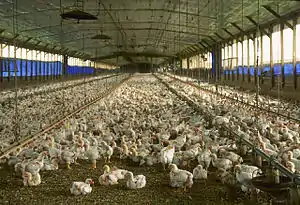
Chickens farmed for meat are called broilers. Chickens will naturally live for six or more years, but broiler breeds typically take less than six weeks to reach slaughter size.[62] A free range or organic broiler will usually be slaughtered at about 14 weeks of age.
Reared for eggs
Chickens farmed primarily for eggs are called layer hens. In total, the UK alone consumes more than 34 million eggs per day.[63] Some hen breeds can produce over 300 eggs per year, with "the highest authenticated rate of egg laying being 371 eggs in 364 days".[64] After 12 months of laying, the commercial hen's egg-laying ability starts to decline to the point where the flock is commercially unviable. Hens, particularly from battery cage systems, are sometimes infirm or have lost a significant amount of their feathers, and their life expectancy has been reduced from around seven years to less than two years.[65] In the UK and Europe, laying hens are then slaughtered and used in processed foods or sold as "soup hens".[65] In some other countries, flocks are sometimes force moulted, rather than being slaughtered, to re-invigorate egg-laying. This involves complete withdrawal of food (and sometimes water) for 7–14 days[66] or sufficiently long to cause a body weight loss of 25 to 35%,[67] or up to 28 days under experimental conditions.[68] This stimulates the hen to lose her feathers, but also re-invigorates egg-production. Some flocks may be force-moulted several times. In 2003, more than 75% of all flocks were moulted in the US.[69]
As pets
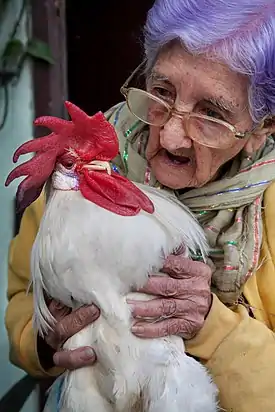
Keeping chickens as pets became increasingly popular in the 2000s[70] among urban and suburban residents.[71] Many people obtain chickens for their egg production but often name them and treat them as any other pet. Chickens are just like any other pet in that they provide companionship and have individual personalities. While many do not cuddle much, they will eat from one's hand, respond to and follow their handlers, as well as show affection.[72]
Chickens are social, inquisitive, intelligent[73] birds, and many find their behaviour entertaining.[74] Certain breeds, such as Silkies and many bantam varieties, are generally docile and are often recommended as good pets around children with disabilities.[75] Many people feed chickens in part with kitchen food scraps.
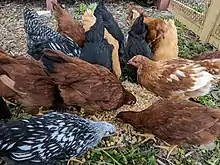
Chickens can carry and transmit salmonella in their dander and feces. In the United States, the Centers for Disease Control and Prevention advise against bringing them indoors or letting small children handle them.[76][77]
Cockfight
Chickens were originally used for cockfighting, a sport where 2 male chickens or "cocks" fight each other until one dies or becomes badly injured. Cocks possess congenital aggression toward all other cocks to contest with females. Studies suggest that cockfights have existed even up to the Indus Valley Civilisation as a pastime.[78] Today it is commonly associated with religious worship, pastime, and gambling in Asian and some South American countries. While not all fights are to the death, most use metal spurs as a "weapon" attached above or below the chicken's own spur and with this typically results in death in one or both cocks. If chickens are in practice owners place gloves on the spurs to prevent injuries. It has been banned it most western countries and debated by animal rights activist for its brutality.
Artificial incubation

Incubation can successfully occur artificially in machines that provide the correct, controlled environment for the developing chick.[79][80] The average incubation period for chickens is 21 days but may depend on the temperature and humidity in the incubator. Temperature regulation is the most critical factor for a successful hatch. Variations of more than 1 °C (1.8 °F) from the optimum temperature of 37.5 °C (99.5 °F) will reduce hatch rates. Humidity is also important because the rate at which eggs lose water by evaporation depends on the ambient relative humidity. Evaporation can be assessed by candling, to view the size of the air sac, or by measuring weight loss. Relative humidity should be increased to around 70% in the last three days of incubation to keep the membrane around the hatching chick from drying out after the chick cracks the shell. Lower humidity is usual in the first 18 days to ensure adequate evaporation. The position of the eggs in the incubator can also influence hatch rates. For best results, eggs should be placed with the pointed ends down and turned regularly (at least three times per day) until one to three days before hatching. If the eggs aren't turned, the embryo inside may stick to the shell and may hatch with physical defects. Adequate ventilation is necessary to provide the embryo with oxygen. Older eggs require increased ventilation.
Many commercial incubators are industrial-sized with shelves holding tens of thousands of eggs at a time, with rotation of the eggs a fully automated process. Home incubators are boxes holding from 6 to 75 eggs; they are usually electrically powered, but in the past some were heated with an oil or paraffin lamp.
Diseases and ailments
Chickens are susceptible to several parasites, including lice, mites, ticks, fleas, and intestinal worms, as well as other diseases. Despite the name, they are not affected by chickenpox, which is generally restricted to humans.[81]
Some of the diseases that can affect chickens are shown below:
History
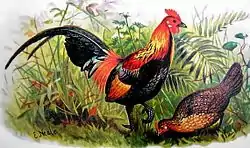
An early domestication of chickens in Southeast Asia is probable, since the word for domestic chicken (*manuk) is part of the reconstructed Proto-Austronesian language . Chickens, together with dogs and pigs, were the domestic animals of the Lapita culture,[84] the first Neolithic culture of Oceania.[85]
The first pictures of chickens in Europe are found on Corinthian pottery of the 7th century BC.[86][87]
Chickens were spread by Polynesian seafarers and reached Easter Island in the 12th century AD, where they were the only domestic animal, with the possible exception of the Polynesian rat (Rattus exulans). They were housed in extremely solid chicken coops built from stone, which was first reported as such to Linton Palmer in 1868, who also "expressed his doubts about this".[88]
See also
- Urban chicken keeping
- Abnormal behaviour of birds in captivity
- Battery Hen Welfare Trust, a UK charity for laying hens
- Chicken as food
- Chicken eyeglasses
- Chicken fat
- Chicken hypnotism
- Chicken or the egg
- Chicken manure
- Chook raffle – a type of raffle where the prize is a chicken.
- Early feeding
- Feral chicken
- Gamebird hybrids – hybrids between chickens, peafowl, guineafowl and pheasants
- Henopause
- List of chicken breeds
- Poularde
- Rubber chicken
- Sex change in chickens
- Symbolic chickens
- Tastes like chicken
- Unihemispheric slow-wave sleep
- "Why did the chicken cross the road?"
Notes
- (surgical and chemical castration are now illegal in some parts of the world)
References
- "Number of chickens worldwide from 1990 to 2018". Statista. Retrieved February 23, 2020.
- UN's Food and Agriculture Organisation (July 2011). "Global Livestock Counts". The Economist. Archived from the original on July 15, 2016. Retrieved July 13, 2017.
- "The Ancient City Where People Decided to Eat Chickens". Archived from the original on May 16, 2018. Retrieved May 15, 2018.
- Perry-Gal, Lee; Erlich, Adi; Gilboa, Ayelet; Bar-Oz, Guy (August 11, 2015). "Earliest economic exploitation of chicken outside East Asia: Evidence from the Hellenistic Southern Levant". Proceedings of the National Academy of Sciences. 112 (32): 9849–9854. Bibcode:2015PNAS..112.9849P. doi:10.1073/pnas.1504236112. PMC 4538678. PMID 26195775.
- Xiang, Hai; Gao, Jianqiang; Yu, Baoquan; Zhou, Hui; Cai, Dawei; Zhang, Youwen; Chen, Xiaoyong; Wang, Xi; Hofreiter, Michael; Zhao, Xingbo (December 9, 2014). "Early Holocene chicken domestication in northern China". Proceedings of the National Academy of Sciences. 111 (49): 17564–17569. Bibcode:2014PNAS..11117564X. doi:10.1073/pnas.1411882111. PMC 4267363. PMID 25422439.
- Maguelonne Toussaint-Samat, (Anthea Bell, translator) The History of Food, Ch. 11 "The History of Poultry", revised ed. 2009, p. 306.
- Carter, Howard (April 1923). "An Ostracon Depicting a Red Jungle-Fowl (The Earliest Known Drawing of the Domestic Cock)". The Journal of Egyptian Archaeology. 9 (1/2): 1–4. doi:10.2307/3853489. JSTOR 3853489.
- Pritchard, Earl H. "The Asiatic Campaigns of Thutmose III". Ancient Near East Texts related to the Old Testament. p. 240.
- Roehrig, Catharine H.; Dreyfus, Renée; Keller, Cathleen A. (2005). Hatshepsut: From Queen to Pharaoh. New York: Metropolitan Museum of Art. p. 268. ISBN 978-1-58839-173-5. Retrieved November 26, 2015.
- Dohner, Janet Vorwald (January 1, 2001). The Encyclopedia of Historic and Endangered Livestock and Poultry Breeds. Yale University Press. ISBN 978-0300138139. Archived from the original on June 28, 2016. Retrieved February 14, 2016.
- Definition of "chook". Encarta. Archived from the original on April 9, 2009.
an offensive term that deliberately insults a woman's age or appearance (slang)
- Cockerel. Dictionary.reference.com. Archived from the original on March 7, 2016. Retrieved August 29, 2010.
- Pullet. Dictionary.reference.com. Archived from the original on November 9, 2010. Retrieved August 29, 2010.
- Berhardt, Clyde E. B. (1986). I Remember: Eighty Years of Black Entertainment, Big Bands. Philadelphia: University of Pennsylvania Press. p. 153. ISBN 978-0-8122-8018-0. OCLC 12805260.
- "Info on Chicken Care". Ideas-4-pets.co.uk. 2003. Archived from the original on June 25, 2015. Retrieved August 13, 2008.
- D Lines (July 27, 2013). "Chicken Kills Rattlesnake". YouTube. Retrieved March 13, 2019.
- Gerard P.Worrell AKA "Farmer Jerry". "Frequently asked questions about chickens & eggs". Gworrell.freeyellow.com. Archived from the original on September 16, 2008. Retrieved August 13, 2008.
- "The Poultry Guide – A to Z and FAQs". Ruleworks.co.uk. Archived from the original on November 28, 2010. Retrieved August 29, 2010.
- Smith, Jamon (August 6, 2006). "World's oldest chicken starred in magic shows, was on 'Tonight Show'". Tuscaloosa News. Alabama, USA. Archived from the original on February 20, 2019. Retrieved May 18, 2020.
- "Introducing new hens to a flock " Musings from a Stonehead". Stonehead.wordpress.com. Archived from the original on August 13, 2010. Retrieved August 29, 2010.
- "Top cock: Roosters crow in pecking order". Archived from the original on January 15, 2018. Retrieved January 14, 2018.
- Evans, Christopher S.; Evans, Linda; Marler, Peter (July 1993). "On the meaning of alarm calls: functional reference in an avian vocal system". Animal Behaviour. 46 (1): 23–38. doi:10.1006/anbe.1993.1158. S2CID 53165305.
- Grandin, Temple; Johnson, Catherine (2005). Animals in Translation. New York City: Scribner. pp. 69–71. ISBN 978-0-7432-4769-6.
- Cheng, Kimberly M.; Burns, Jeffrey T. (August 1988). "Dominance Relationship and Mating Behavior of Domestic Cocks: A Model to Study Mate-Guarding and Sperm Competition in Birds". The Condor. 90 (3): 697–704. doi:10.2307/1368360. JSTOR 1368360.
- Sherwin, C.M.; Nicol, C.J. (1993). "Factors influencing floor-laying by hens in modified cages". Applied Animal Behaviour Science. 36 (2–3): 211–222. doi:10.1016/0168-1591(93)90011-d.
- Ali, A.; Cheng, K.M. (1985). "Early egg production in genetically blind (rc/rc) chickens in comparison with sighted (Rc+/rc) controls". Poultry Science. 64 (5): 789–794. doi:10.3382/ps.0640789. PMID 4001066.
- "Chickens team up to 'peck fox to death'". The Independent. March 13, 2019. Archived from the original on March 15, 2019. Retrieved March 13, 2019.
- "Chickens 'gang up' to kill fox". Bbc.co.uk. March 13, 2019. Archived from the original on March 14, 2019. Retrieved March 13, 2019.
- AFP (March 12, 2019). "Chickens 'teamed up to kill fox' at Brittany farming school". Theguardian.com. Archived from the original on March 13, 2019. Retrieved March 13, 2019.
- "Check this out! This hawk thought he'd have a chicken dinner until he met our hens". Rustic Road Farm – via Facebook.
- Young, John J.; Tabin, Clifford J. (September 2017). "Saunders's framework for understanding limb development as a platform for investigating limb evolution". Developmental Biology. 429 (2): 401–408. doi:10.1016/j.ydbio.2016.11.005. PMC 5426996. PMID 27840200.
- Scientists Find Chickens Retain Ancient Ability to Grow Teeth Archived June 20, 2008, at the Wayback Machine Ammu Kannampilly, ABC News, February 27, 2006. Retrieved October 1, 2007.
- International Chicken Genome Sequencing Consortium (December 9, 2004). "Sequence and comparative analysis of the chicken genome provide unique perspectives on vertebrate evolution". Nature. 432 (7018): 695–716. Bibcode:2004Natur.432..695C. doi:10.1038/nature03154. PMID 15592404.
- Warren, Wesley C.; Hillier, LaDeana W.; Tomlinson, Chad; Minx, Patrick; Kremitzki, Milinn; Graves, Tina; Markovic, Chris; Bouk, Nathan; Pruitt, Kim D.; Thibaud-Nissen, Francoise; Schneider, Valerie; Mansour, Tamer A.; Brown, C. Titus; Zimin, Aleksey; Hawken, Rachel; Abrahamsen, Mitch; Pyrkosz, Alexis B.; Morisson, Mireille; Fillon, Valerie; Vignal, Alain; Chow, William; Howe, Kerstin; Fulton, Janet E.; Miller, Marcia M.; Lovell, Peter; Mello, Claudio V.; Wirthlin, Morgan; Mason, Andrew S.; Kuo, Richard; Burt, David W.; Dodgson, Jerry B.; Cheng, Hans H. (January 2017). "A New Chicken Genome Assembly Provides Insight into Avian Genome Structure". G3. 7 (1): 109–117. doi:10.1534/g3.116.035923. PMC 5217101. PMID 27852011.
- Gou, Xiao; Li, Ning; Lian, Linsheng; Yan, Dawei; Zhang, Hao; Wei, Zhehui; Wu, Changxin (June 2007). "Hypoxic adaptations of hemoglobin in Tibetan chick embryo: High oxygen-affinity mutation and selective expression". Comparative Biochemistry and Physiology Part B: Biochemistry and Molecular Biology. 147 (2): 147–155. doi:10.1016/j.cbpb.2006.11.031. PMID 17360214.
- Zhang, H.; Wang, X.T.; Chamba, Y.; Ling, Y.; Wu, C.X. (October 2008). "Influences of Hypoxia on Hatching Performance in Chickens with Different Genetic Adaptation to High Altitude". Poultry Science. 87 (10): 2112–2116. doi:10.3382/ps.2008-00122. ISSN 0032-5791. PMID 18809874.
- Pennisi, Elizabeth (May 24, 2018). "Quaillike creatures were the only birds to survive the dinosaur-killing asteroid impact". Science. doi:10.1126/science.aau2802.
- Wong, G. K.; Liu, B.; Wang, J.; Zhang, Y.; Yang, X.; Zhang, Z.; Meng, Q.; Zhou, J.; Li, D.; Zhang, J.; Ni, P.; Li, S.; Ran, L.; Li, H.; Zhang, J.; Li, R.; Li, S.; Zheng, H.; Lin, W.; Li, G.; Wang, X.; Zhao, W.; Li, J.; Ye, C.; Dai, M.; Ruan, J.; Zhou, Y.; Li, Y.; He, X.; et al. (December 9, 2004). "A genetic variation map for chicken with 2.8 million single nucleotide polymorphisms". Nature. 432 (7018): 717–722. Bibcode:2004Natur.432..717B. doi:10.1038/nature03156. PMC 2263125. PMID 15592405.
- Lawal, Raman Akinyanju; Martin, Simon H.; Vanmechelen, Koen; Vereijken, Addie; Silva, Pradeepa; Al-Atiyat, Raed Mahmoud; Aljumaah, Riyadh Salah; Mwacharo, Joram M.; Wu, Dong-Dong; Zhang, Ya-Ping; Hocking, Paul M.; Smith, Jacqueline; Wragg, David; Hanotte, Olivier (December 2020). "The wild species genome ancestry of domestic chickens". BMC Biology. 18 (1): 13. doi:10.1186/s12915-020-0738-1. PMC 7014787. PMID 32050971.
- Eriksson, Jonas; Larson, Greger; Gunnarsson, Ulrika; Bed'hom, Bertrand; Tixier-Boichard, Michele; Strömstedt, Lina; Wright, Dominic; Jungerius, Annemieke; Vereijken, Addie; Randi, Ettore; Jensen, Per; Andersson, Leif (February 29, 2008). "Identification of the Yellow Skin Gene Reveals a Hybrid Origin of the Domestic Chicken". PLOS Genetics. 4 (2): e1000010. doi:10.1371/journal.pgen.1000010. PMC 2265484. PMID 18454198.
- Fumihito, A; Miyake, T; Sumi, S; Takada, M; Ohno, S; Kondo, N (December 20, 1994), "One subspecies of the red junglefowl (Gallus gallus gallus) suffices as the matriarchic ancestor of all domestic breeds", PNAS, 91 (26): 12505–12509, Bibcode:1994PNAS...9112505F, doi:10.1073/pnas.91.26.12505, PMC 45467, PMID 7809067
- Liu, Yi-Ping; Wu, Gui-Sheng; Yao, Yong-Gang; Miao, Yong-Wang; Luikart, Gordon; Baig, Mumtaz; Beja-Pereira, Albano; Ding, Zhao-Li; Palanichamy, Malliya Gounder; Zhang, Ya-Ping (January 2006). "Multiple maternal origins of chickens: Out of the Asian jungles". Molecular Phylogenetics and Evolution. 38 (1): 12–19. doi:10.1016/j.ympev.2005.09.014. PMID 16275023.
- Zeder, Melinda A.; Emshwiller, Eve; Smith, Bruce D.; Bradley, Daniel G. (March 2006). "Documenting domestication: the intersection of genetics and archaeology". Trends in Genetics. 22 (3): 139–155. doi:10.1016/j.tig.2006.01.007. PMID 16458995.
- King, Rick (February 24, 2009), "Rat Attack", NOVA and National Geographic Television, archived from the original on August 23, 2017, retrieved August 25, 2017
- King, Rick (February 1, 2009), "Plant vs. Predator", NOVA, archived from the original on August 21, 2017, retrieved August 25, 2017
- West, B.; Zhou, B.X. (1988). "Did chickens go north? New evidence for domestication". J. Archaeol. Sci. 14 (5): 515–533. doi:10.1016/0305-4403(88)90080-5.
- Al-Nasser, A.; Al-Khalaifa, H.; Al-Saffar, A.; Khalil, F.; Albahouh, M.; Ragheb, G.; Al-Haddad, A.; Mashaly, M. (June 1, 2007). "Overview of chicken taxonomy and domestication". World's Poultry Science Journal. 63 (2): 285–300. doi:10.1017/S004393390700147X. S2CID 86734013.
- CHOF : The Cambridge History of Food, 2000, Cambridge University Press, vol.1, pp496-499
- Brown, Marley (September–October 2017). "Fast Food". Archaeology. 70 (5): 18. ISSN 0003-8113. Retrieved July 25, 2019.
- Borrell, Brendan (June 1, 2007). "DNA reveals how the chicken crossed the sea". Nature. 447 (7145): 620–621. Bibcode:2007Natur.447R.620B. doi:10.1038/447620b. PMID 17554271. S2CID 4418786.
- Storey, A. A.; Ramirez, J. M.; Quiroz, D.; Burley, D. V.; Addison, D. J.; Walter, R.; Anderson, A. J.; Hunt, T. L.; Athens, J. S.; Huynen, L.; Matisoo-Smith, E. A. (June 19, 2007). "Radiocarbon and DNA evidence for a pre-Columbian introduction of Polynesian chickens to Chile". Proceedings of the National Academy of Sciences. 104 (25): 10335–10339. Bibcode:2007PNAS..10410335S. doi:10.1073/pnas.0703993104. PMC 1965514. PMID 17556540.
- Wilford, John Noble (June 5, 2007). "First Chickens in Americas Were Brought From Polynesia". The New York Times.
- Gongora, Jaime; Rawlence, Nicolas J.; Mobegi, Victor A.; Jianlin, Han; Alcalde, Jose A.; Matus, Jose T.; Hanotte, Olivier; Moran, Chris; Austin, J.; Ulm, Sean; Anderson, Atholl J.; Larson, Greger; Cooper, Alan (2008). "Indo-European and Asian origins for Chilean and Pacific chickens revealed by mtDNA". PNAS. 105 (30): 10308–10313. Bibcode:2008PNAS..10510308G. doi:10.1073/pnas.0801991105. PMC 2492461. PMID 18663216.
- Thomson, Vicki A.; Lebrasseur, Ophélie; Austin, Jeremy J.; Hunt, Terry L.; Burney, David A.; Denham, Tim; Rawlence, Nicolas J.; Wood, Jamie R.; Gongora, Jaime; Girdland Flink, Linus; Linderholm, Anna; Dobney, Keith; Larson, Greger; Cooper, Alan (April 1, 2014). "Using ancient DNA to study the origins and dispersal of ancestral Polynesian chickens across the Pacific". Proceedings of the National Academy of Sciences. 111 (13): 4826–4831. Bibcode:2014PNAS..111.4826T. doi:10.1073/pnas.1320412111. PMC 3977275. PMID 24639505.
- Jones, E.K.M.; Prescott, N.B. (2000). "Visual cues used in the choice of mate by fowl and their potential importance for the breeder industry". World's Poultry Science Journal. 56 (2): 127–138. doi:10.1079/WPS20000010. S2CID 86481908.
- "About chickens | Compassion in World Farming". Ciwf.org.uk. Archived from the original on April 26, 2017. Retrieved April 25, 2017.
- Fereira, John. "Poultry Slaughter Annual Summary". usda.mannlib.cornell.edu. Archived from the original on April 26, 2017. Retrieved April 25, 2017.
- Fereira, John. "Chickens and Eggs Annual Summary". usda.mannlib.cornell.edu. Archived from the original on April 26, 2017. Retrieved April 25, 2017.
- "Towards Happier Meals In A Globalized World". World Watch Institute. Archived from the original on May 29, 2014. Retrieved May 29, 2014.
- Ilea, Ramona Cristina (April 2009). "Intensive Livestock Farming: Global Trends, Increased Environmental Concerns, and Ethical Solutions". Journal of Agricultural and Environmental Ethics. 22 (2): 153–167. doi:10.1007/s10806-008-9136-3. S2CID 154306257.
- Tilman, David; Cassman, Kenneth G.; Matson, Pamela A.; Naylor, Rosamond; Polasky, Stephen (August 2002). "Agricultural sustainability and intensive production practices". Nature. 418 (6898): 671–677. Bibcode:2002Natur.418..671T. doi:10.1038/nature01014. PMID 12167873. S2CID 3016610.
- "Broiler Chickens Fact Sheet // Animals Australia". Animalsaustralia.org. Archived from the original on July 12, 2010. Retrieved August 29, 2010.
- "UK Egg Industry Data | Official Egg Info". Egginfo.co.uk. Archived from the original on December 30, 2016. Retrieved April 25, 2017.
- Guinness World Records 2011 ed. by Craig Glenday – page 286
- Browne, Anthony (March 10, 2002). "Ten weeks to live". The Guardian. London. Archived from the original on May 16, 2008. Retrieved April 28, 2010.
- Patwardhan, D.; King, A. (2011). "Review: feed withdrawal and non feed withdrawal moult". World's Poultry Science Journal. 67 (2): 253–268. doi:10.1017/s0043933911000286. S2CID 88353703.
- Webster, A.B. (2003). "Physiology and behavior of the hen during induced moult". Poultry Science. 82 (6): 992–1002. doi:10.1093/ps/82.6.992. PMID 12817455.
- Molino, A.B.; Garcia, E.A.; Berto, D.A.; Pelícia, K.; Silva, A.P.; Vercese, F. (2009). "The Effects of Alternative Forced-Molting Methods on The Performance and Egg Quality of Commercial Layers". Brazilian Journal of Poultry Science. 11 (2): 109–113. doi:10.1590/s1516-635x2009000200006.
- Yousaf, M.; Chaudhry, A.S. (March 1, 2008). "History, changing scenarios and future strategies to induce moulting in laying hens" (PDF). World's Poultry Science Journal. 64 (1): 65–75. doi:10.1017/s0043933907001729. S2CID 34761543.
- Fly, Colin (July 27, 2007). "Some homeowners find chickens all the rage". Chicago Tribune.
- Pollack-Fusi, Mindy (December 16, 2004). "Cooped up in suburbia". Boston Globe.
- Boone, Lisa. "Chickens will become a beloved pet — just like the family dog". latimes.com. Retrieved April 3, 2019.
- Barras, Colin. "Despite what you might think, chickens are not stupid". www.bbc.com. Retrieved September 6, 2020.
- United Poultry Concerns. "Providing a Good Home for Chickens". Archived from the original on June 5, 2009. Retrieved May 4, 2009.
- "Choosing Your Chickens". Clucks and Chooks. Archived from the original on July 30, 2009.
- "Forget dogs and cats. The most pampered pets of the moment might be our backyard chickens". USA TODAY. Retrieved April 3, 2019.
- CDC (March 18, 2019). "Keeping Backyard Poultry". Centers for Disease Control and Prevention. Retrieved April 3, 2019.
- Sherman, David M. (2002). Tending Animals in the Global Village. Blackwell Publishing. 46. ISBN 0-683-18051-7.
- Joe G. Berry. "Artificial Incubation". Oklahoma Cooperative Extension Service, Oklahoma State University. Archived (PDF) from the original on June 4, 2010. Retrieved September 29, 2010.
- Phillip J. Clauer. "Incubating Eggs" (PDF). Virginia Cooperative Extension Service, Virginia State University. Archived (PDF) from the original on June 13, 2010. Retrieved October 1, 2010.
- White, Tiffany M.; Gilden, Donald H.; Mahalingam, Ravi (October 2001). "An Animal Model of Varicella Virus Infection". Brain Pathology. 11 (4): 475–479. doi:10.1111/j.1750-3639.2001.tb00416.x. PMID 11556693. S2CID 26073177.
- "Overview of Omphalitis in Poultry". Merck Veterinary Manual. Archived from the original on January 13, 2017. Retrieved January 10, 2017.
- "Clucks and Chooks: guide to keeping chickens". Henkeeping.co.uk. Archived from the original on January 15, 2010. Retrieved October 26, 2009.
- Meleisea, Malama (March 25, 2004). The Cambridge History of the Pacific Islanders. Cambridge University Press. p. 56. ISBN 9780521003544. Archived from the original on September 13, 2016. Retrieved March 13, 2019 – via Google Books.
- Crawford, Michael H. (March 13, 2019). Anthropological Genetics: Theory, Methods and Applications. Cambridge University Press. p. 411. ISBN 9780521546973. Archived from the original on September 13, 2016. Retrieved March 13, 2019 – via Google Books.
- Karayanis, Dean; Karayanis, Catherine (March 13, 2019). Regional Greek Cooking. Hippocrene Books. p. 176. ISBN 9780781811460. Archived from the original on September 13, 2016. Retrieved March 13, 2019 – via Google Books.
- Chiffolo, Anthony F.; Hesse, Rayner W. (March 13, 2019). Cooking with the Bible: Biblical Food, Feasts, and Lore. Greenwood Publishing Group. p. 207. ISBN 9780313334108. Archived from the original on September 13, 2016. Retrieved March 13, 2019 – via Google Books.
- Flenley, John; Bahn, Paul (May 29, 2003). The Enigmas of Easter Island. Oxford University Press, UK. p. 6. ISBN 9780191587917. Archived from the original on September 13, 2016. Retrieved March 13, 2019 – via Google Books.
Further reading
- Green-Armytage, Stephen (October 2000). Extraordinary Chickens. Harry N. Abrams. ISBN 978-0-8109-3343-9.
- Smith, Page; Charles Daniel (April 2000). The Chicken Book. University of Georgia Press. ISBN 978-0-8203-2213-1.
- Biswas, Siddharth (April 2014). "Gallus gallus domesticus Linnaeus, 1758: Keep safe your domestic fowl from your domestic foul". Ambient Science. 1 (1): 41–43. doi:10.21276/ambi.2014.01.1.nn02.
- Andrew Lawler (2014). Why Did the Chicken Cross the World?: The Epic Saga of the Bird that Powers Civilization. Atria Books. ISBN 978-1-4767-2989-3.
External links
| Wikimedia Commons has media related to Chickens. |
| Wikispecies has information related to Gallus gallus domesticus. |
